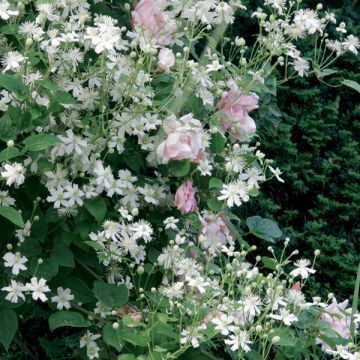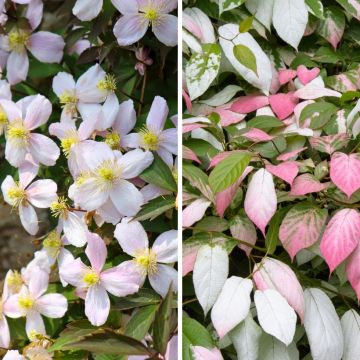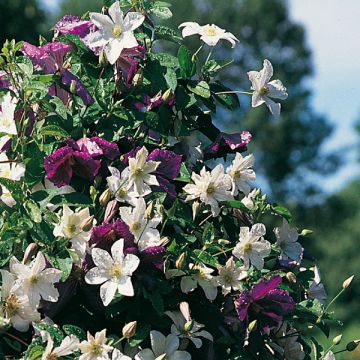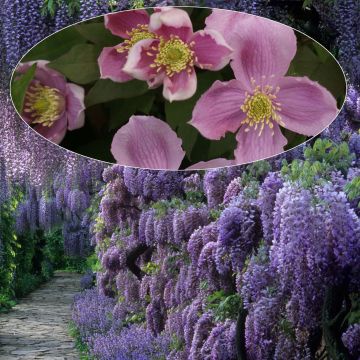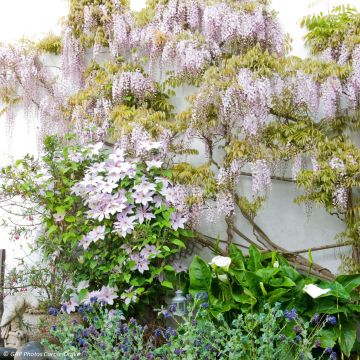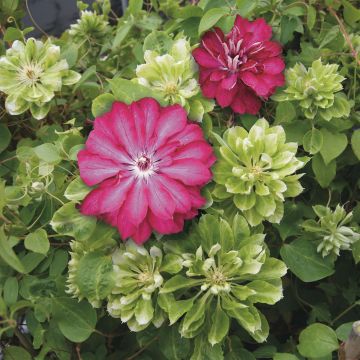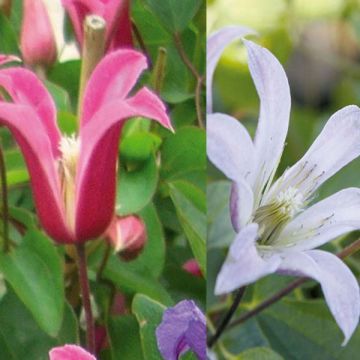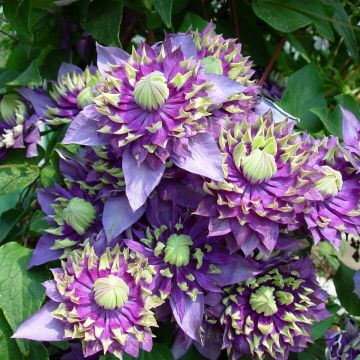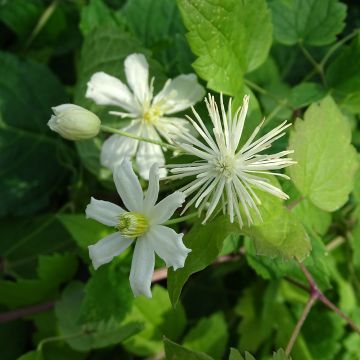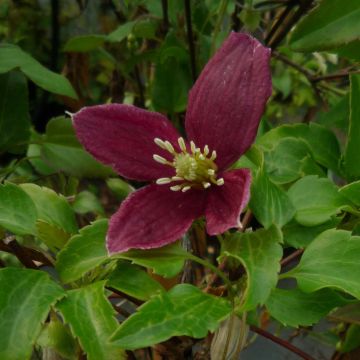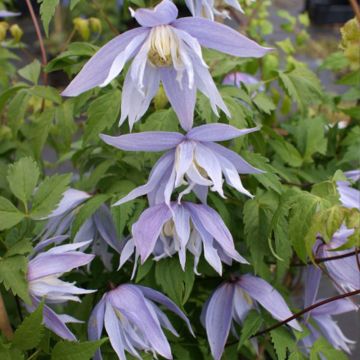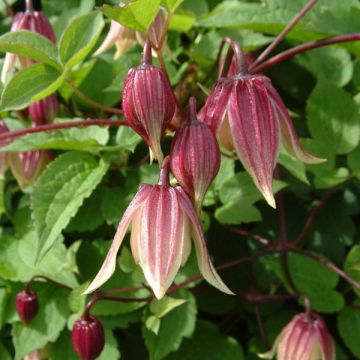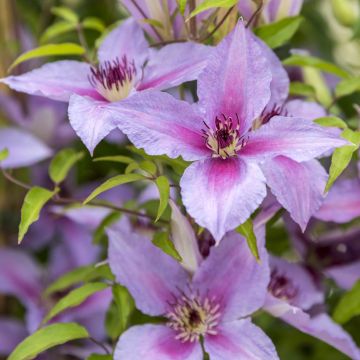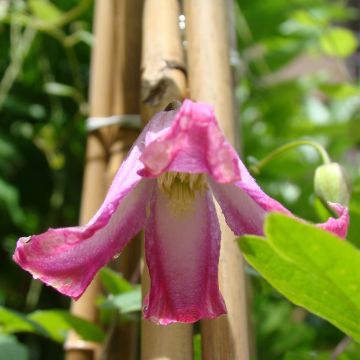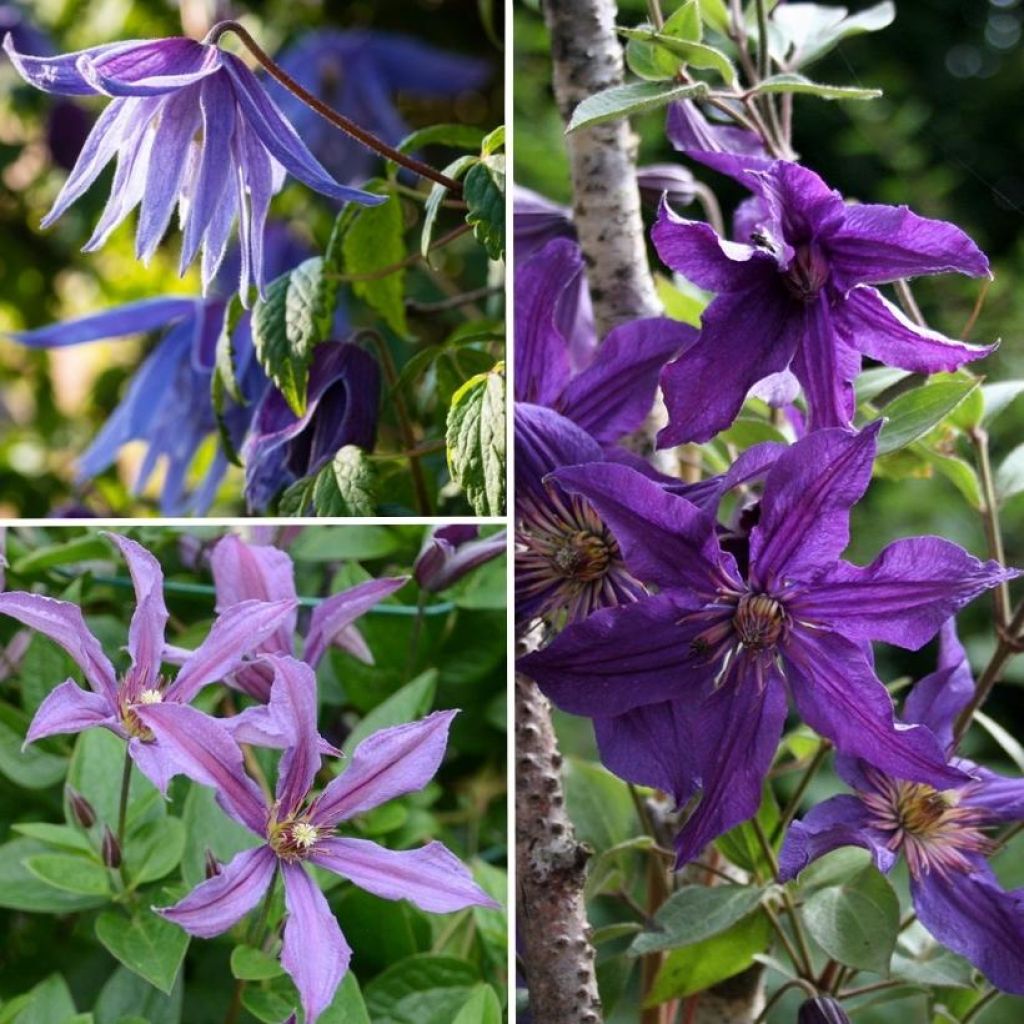

Collection 3 clématites à petit prix
Clematis collection in shades of blue-violet
Clematis
Clematis, Old Man's Beard, Traveller's Joy, Virgin's Bower
This item cannot be shipped to the selected country
Delivery charge from €5.90
More information
Schedule delivery date,
and select date in basket
This plant carries a 6 months recovery warranty
More information
We guarantee the quality of our plants for a full growing cycle, and will replace at our expense any plant that fails to recover under normal climatic and planting conditions.
From €5.90 for pickup delivery and €6.90 for home delivery
Express home delivery from €8.90.
Does this plant fit my garden?
Set up your Plantfit profile →
Collection items (3 plants)
Description
This Collection of 3 Clematis at affordable prices, available in pots, allows all gardeners to enjoy the beauty of flowering plants while managing their budget. It brings together two excellent varieties from the Saphyra series, which are very compact, hardy, disease-resistant, and prolific, along with a botanical species that charms with its early, abundant, and delicate flowering. Their flowering period, in shades of mauve to violet, extends from March to September. Their modest growth is suitable for small gardens as well as for terraces and balconies. Plant them in rich, moist, well-drained soil.
This collection consists of:
1x Clematis Saphyra Estrella: an excellent INRA cultivar, this Clematis is more bushy than climbing and does not exceed 1 meter (3 feet) in all directions. Its foliage disappears completely in winter and re-emerges in spring with numerous leafy stems that arise directly from the stump. It blooms from June to September, with 7-8 cm (3in) diameter star-shaped flowers in a blue-violet color. Its foliage is deciduous. Perfectly hardy, it is disease-resistant.
1 x Clematis 'Saphyra® Violetta': similar to the previous one, but produces larger velvety violet flowers, reaching 10-12 cm (4-5in) in diameter.
1 x Clematis macropetala: a botanical species that is more creeping than climbing, semi-woody, reaching about 2.50 m (8ft). Its pendulous bell-shaped semi-double flowers in a blue-mauve colour bloom from March to May, and sometimes in summer. Its feathery silver fruits remain decorative for a long time. It can also be grown in a large pot.
Clematis belong to the Ranunculaceae family. They are found in both hemispheres, particularly in Europe, the Himalayas, China, Australia, and North and Central America. The three varieties in this collection are perfectly perennial and hardy plants. Their foliage is deciduous, forming in spring and falling in autumn. These plants cling to supports or neighbouring plants through petioles transformed into tendrils. They bloom on new shoots.
Plant these Clematis alongside your white, red, pink, or purple roses to accompany their flowering and fill in the bare ground around their base. Clematis represent a diverse genus, with varieties available in all colours, shapes, and sizes. Take advantage of their easy cultivation to give your garden a romantic and bohemian touch. The 'Saphyra' varieties will thrive perfectly in pots on a balcony. In the garden, they will complement abelias and deutzias. Alternatively, they can spread on the ground, for example, on a bank. Place the Clematis macropetala next to your Japanese quinces, ornamental apple trees, or flowering cherries that bloom at the same time. These beautiful plants will enhance all spring-flowering shrubs.
Our advice: young plants in pots will benefit from being repotted into 20-25 cm (8-10in) diameter pots, where they should receive careful care for a few months. This will allow them to develop their root system better before planting them into the ground.
Report an error about the product description
Plant habit
Flowering
Foliage
Botanical data
Clematis
Renonculaceae
Clematis, Old Man's Beard, Traveller's Joy, Virgin's Bower
Cultivar or hybrid
Other Clematis collections
Planting and care
Plant the clematis preferably in the sun, in a fertile, humus-rich, well-drained soil, shading the roots and base of the stem (with a flat tile, for example). Herbaceous species prefer full sun and wilt in overly moist soil. Plant them by covering the root ball with 3 cm (1in) of soil, in a worked soil of 20 cm (8in), lightened with good compost. During the first few weeks, water regularly, but avoid stagnant water as it can cause collar rot. Cover the base of climbing clematis with a small mound of soil to reduce the risk of wilting, while promoting vigorous shoots from the stump. After planting, prune the stems of deciduous climbing clematis to about 30 cm (12in) from the base, above a healthy pair of buds. Mulch in February with garden compost or well-rotted manure, avoiding direct contact with the stems. Train the stems, without squeezing them, until the plant can cling by itself. Clematis also like to grow freely on neighbouring plants. This variety flowers on new shoots, so prune it quite severely in late winter. Be aware that the young shoots attract slugs, while voles and grey worm can attack them and devour the stems. Aphids and greenhouse whitefly are also potential parasites.
Planting period
Intended location
Care
-
, onOrder confirmed
Reply from on Promesse de fleurs
Clematis
Haven't found what you were looking for?
Hardiness is the lowest winter temperature a plant can endure without suffering serious damage or even dying. However, hardiness is affected by location (a sheltered area, such as a patio), protection (winter cover) and soil type (hardiness is improved by well-drained soil).

Photo Sharing Terms & Conditions
In order to encourage gardeners to interact and share their experiences, Promesse de fleurs offers various media enabling content to be uploaded onto its Site - in particular via the ‘Photo sharing’ module.
The User agrees to refrain from:
- Posting any content that is illegal, prejudicial, insulting, racist, inciteful to hatred, revisionist, contrary to public decency, that infringes on privacy or on the privacy rights of third parties, in particular the publicity rights of persons and goods, intellectual property rights, or the right to privacy.
- Submitting content on behalf of a third party;
- Impersonate the identity of a third party and/or publish any personal information about a third party;
In general, the User undertakes to refrain from any unethical behaviour.
All Content (in particular text, comments, files, images, photos, videos, creative works, etc.), which may be subject to property or intellectual property rights, image or other private rights, shall remain the property of the User, subject to the limited rights granted by the terms of the licence granted by Promesse de fleurs as stated below. Users are at liberty to publish or not to publish such Content on the Site, notably via the ‘Photo Sharing’ facility, and accept that this Content shall be made public and freely accessible, notably on the Internet.
Users further acknowledge, undertake to have ,and guarantee that they hold all necessary rights and permissions to publish such material on the Site, in particular with regard to the legislation in force pertaining to any privacy, property, intellectual property, image, or contractual rights, or rights of any other nature. By publishing such Content on the Site, Users acknowledge accepting full liability as publishers of the Content within the meaning of the law, and grant Promesse de fleurs, free of charge, an inclusive, worldwide licence for the said Content for the entire duration of its publication, including all reproduction, representation, up/downloading, displaying, performing, transmission, and storage rights.
Users also grant permission for their name to be linked to the Content and accept that this link may not always be made available.
By engaging in posting material, Users consent to their Content becoming automatically accessible on the Internet, in particular on other sites and/or blogs and/or web pages of the Promesse de fleurs site, including in particular social pages and the Promesse de fleurs catalogue.
Users may secure the removal of entrusted content free of charge by issuing a simple request via our contact form.
The flowering period indicated on our website applies to countries and regions located in USDA zone 8 (France, the United Kingdom, Ireland, the Netherlands, etc.)
It will vary according to where you live:
- In zones 9 to 10 (Italy, Spain, Greece, etc.), flowering will occur about 2 to 4 weeks earlier.
- In zones 6 to 7 (Germany, Poland, Slovenia, and lower mountainous regions), flowering will be delayed by 2 to 3 weeks.
- In zone 5 (Central Europe, Scandinavia), blooming will be delayed by 3 to 5 weeks.
In temperate climates, pruning of spring-flowering shrubs (forsythia, spireas, etc.) should be done just after flowering.
Pruning of summer-flowering shrubs (Indian Lilac, Perovskia, etc.) can be done in winter or spring.
In cold regions as well as with frost-sensitive plants, avoid pruning too early when severe frosts may still occur.
The planting period indicated on our website applies to countries and regions located in USDA zone 8 (France, United Kingdom, Ireland, Netherlands).
It will vary according to where you live:
- In Mediterranean zones (Marseille, Madrid, Milan, etc.), autumn and winter are the best planting periods.
- In continental zones (Strasbourg, Munich, Vienna, etc.), delay planting by 2 to 3 weeks in spring and bring it forward by 2 to 4 weeks in autumn.
- In mountainous regions (the Alps, Pyrenees, Carpathians, etc.), it is best to plant in late spring (May-June) or late summer (August-September).
The harvesting period indicated on our website applies to countries and regions in USDA zone 8 (France, England, Ireland, the Netherlands).
In colder areas (Scandinavia, Poland, Austria...) fruit and vegetable harvests are likely to be delayed by 3-4 weeks.
In warmer areas (Italy, Spain, Greece, etc.), harvesting will probably take place earlier, depending on weather conditions.
The sowing periods indicated on our website apply to countries and regions within USDA Zone 8 (France, UK, Ireland, Netherlands).
In colder areas (Scandinavia, Poland, Austria...), delay any outdoor sowing by 3-4 weeks, or sow under glass.
In warmer climes (Italy, Spain, Greece, etc.), bring outdoor sowing forward by a few weeks.




































